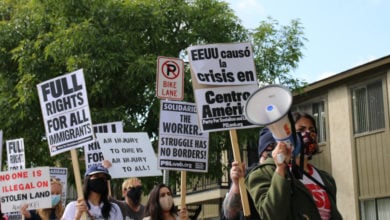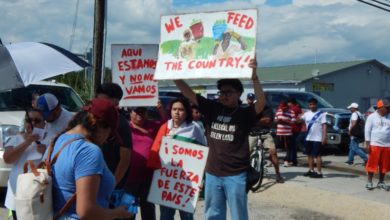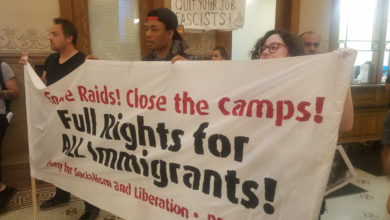What revived May Day as a day of workers’ struggle in the United States was the May 1, 2006, “Day Without an Immigrant” general strike. Six years ago, millions of immigrant workers and their allies marked that day with strikes, walkouts, boycotts of U.S. products, demonstrations and vigils across the country.
It was the largest single working-class action in U.S. history, and arose in response to the draconian “Sensenbrenner” bill that would have criminalized undocumented workers for wanting to work and live in the United States.
Immigrant workers—documented and undocumented—directly defied their employers, the government and police to demand amnesty. Some of the largest corporations in the world—including the food-processing conglomerates—were forced to shut down. The cost of the one-day boycott in Los Angeles alone was $300 million—a fifth of the city’s daily intake.
Amnesty was the central demand that captured the aspirations of millions who filled the streets in cities across the country—that is, full legalization and democratic rights for immigrant workers.
The movement comes to a crossroads
The U.S. ruling class was threatened by this new movement for immigrant rights. Many of the bourgeois “friends” of the immigrant struggle spoke out feverishly against the May 1 “Day Without an Immigrant.”
The Party for Socialism and Liberation wrote in 2006: “What [the ruling class] fears the most is that immigrant workers—indeed, all workers—will feel the political strength that is held in their labor power. The ruling class fears that their political strength will be measured not at the ballot box for one or another ruling class politician, but in their ability to bring about political change through their organization and position as the producers of society’s wealth. It fears that the immigration rights movement will develop a sense of its revolutionary potential.”
The first response of the ruling class was to drop the Sensenbrenner bill. But after this victory over the racist bill, the movement slowly left the streets.
Many of the moderate voices in the immigrant rights movement tied to the Democratic Party encouraged instead a focus on the 2006 congressional elections. The Democrats received overwhelming and dedicated support from many Latino and immigrant communities. Organizers worked tirelessly to support candidates who they believed would end the Bush-era immigration raids that terrorized millions. This support helped the Democrats sweep Congress in 2006 and take the White House in 2008.
Raids and repression increase
As soon as the marches left the streets, the Bush administration greatly increased raids and deportations. As the Democrats came to power, the immigrant rights movement waited in near silence for some reform. But the attacks just escalated.
The Obama administration tweaked the Bush tactic of raid-style enforcement by conducting paper raids targeting employers who hire undocumented workers. It implemented information-sharing systems, such as the notorious Secure Communities, that empower collaboration between local police and Immigration and Customs Enforcement.
The Department of Homeland Security budget remains nearly $60 billion, plus $30 billion in additional allocations that the agency received in 2011. In a time of economic crisis, while services around the country have been slashed and rates of undocumented immigration have sunk to new lows, the government continues to deport more people than ever before.
Ninety percent of those deportations are based on the immigrants’ presence in the United States without immigration papers alone, and not for any conviction or fraud. The Obama administration has already deported more people than were deported under both administrations of George W. Bush combined, skyrocketing above 1 million deported by early 2011.
No progress toward legislative reform
While the broad demand of the 2006 demonstrations was “amnesty” or “legalization now,” the Democratic Party, once in office, shifted the legislative focus away from comprehensive immigration reform. In 2010, Democrats focused on the more narrow “DREAM Act,” a measure that would “legalize” those who came to the United States when they were 15 years old or younger and met other strict criteria. Without a strong movement in the streets, the Senate blocked that bill after it passed the House of Representatives.
Some Democrat-supported reforms would have expanded guest-worker programs, rather than granting immigrant workers full rights. Proposals included harsh provisions, such as new “biometric” Social Security cards to prevent undocumented immigrants from finding work, increased border militarization, mandatory workplace enforcement measures, new immigration-related criminal penalties, fines, long waits, English requirements and “back taxes.”
Over that time, the right wing only grew stronger, winning more congressional seats. This has nearly eliminated pro-immigrant legislative options absent mass struggle.
To be “pragmatic,” moderate immigrant rights organizations and the leadership of prominent unions, like the Service Employees International Union, embraced the Democratic Party strategy. They supported less-than comprehensive reform proposals while failing to mobilize for immigration reform in the streets.
In fact, what is “pragmatic” for ruling-class politicians depends on the level of struggle. The Civil Rights Act of 1964 and the Voting Rights Act of 1965 were not passed in a Congress that was any less racist than the Congress of 1963. There was no lobbying effort that changed the consciousness of the racists who held the seats in the Senate and the House. They acted out of their fear of the movement.
Continued struggle of immigrant rights organizers
Despite the harsh crackdown in the last five years, the struggle has lived on. Young undocumented activists have come out into the streets to announce publicly their undocumented status. When Arizona passed its racist SB 1070 in 2010, which contained many odious similarities to the Sensenbrenner bill, communities immediately mobilized.
Students have held highly visible and militant protests across the country against new state measures like Alabama’s HB 56 and Georgia’s HB 87, as well as against federal measures such as Secure Communities. They have courageously engaged in civil disobedience on roadways, at ICE offices nationwide, and at detention centers, where many have been arrested. Young immigrant rights activists participated in the labor upsurge in Madison, Wisc., in February 2011, and the Occupy Wall Street movement. Their main slogans have been “Immigrant rights are workers’ right,” and “Immigrants are the 99 percent.”
The movement’s unity, organization and mass support have put the Obama administration and ICE on the defensive, especially as the Democratic Party gears up for the 2012 elections. The movement won agreements by ICE to consider halting the deportations of undocumented immigrant youth who would be DREAM Act-eligible.
In the last six months, some organizations have again been calling on immigrants not to protest, but to instead campaign for the Democratic Party to “hold them to their promises.” The consequences of this misleading logic have already been proven. We need to struggle. This May Day can again be historic if we use it to reawaken the sleeping giant and revive the movement that shook the corporate and political establishment to the core six years ago.





